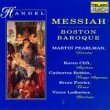AIR (ALTO)But who may abide the day of His coming, and who shall stand when He appeareth? In spite of the frequent, even usual, performance of this aria by a bass, it is likely that not Handel but Mozart, through Vincent Novello’s printing of the score, was responsible for handing it down to us in its complete form for the bass.6 Handel wrote an early abbreviated version of it for bass, without the fast section, and then two other versions (in different keys) including both slow (Larghetto) and fast (Prestissimo) sections, for male alto (the castrato Gaetano Guadagni) and for soprano. In the Handel Gesellschaft edition, the accompanied recitative “Thus saith the Lord” is for bass and this air is for alto. Regardless of the range, Handel’s setting of the text is stunning. CHORUSAnd He shall purify the sons of Levi, that they may offer unto the Lord One of the great stories about Messiah is that Handel composed it in the unbelievably short time of three weeks–August 22 to September 12, 1741. A cynic knowing that Handel borrowed some of his own earlier works for this oratorio would be inclined to minimize the achievement, thinking that reusing music is a shortcut to composing new music. However, there are only four reworked numbers in the entire oratorio, and this chorus is one of them. Originally it was an Italian duet for two sopranos, as were the three other borrowings. The source of this fugue is the third movement of Quel fior che all’alba ride, which Handel wrote earlier in the summer of 1741, about six weeks before beginning Messiah. There seems to be no connection between the text of the fugue and that of duet: “[Life’s] sunset is at dawn, and it loses its springtime in a single day.”7 Handel creates some interesting imagery in this chorus. A key phrase in the work is the second one that the chorus sings. It begins on a leap up to four repeated high eighth notes which occur on the words “He shall puri-....” These four notes seem like short hammer strokes. When followed by the long runs of 16th notes on the final syllable of “purify”, they suggest a shaping and further smelting of metal, continuing the idea of the refiner’s furnace from the previous air. A further “refinement” occurs when the pitches on the words “the sons of Levi” retrace the descending scale that was contained in the first part of the sentence. In other words, the music for the sons of Levi (the priestly line) is the pared-down, “purified” version of that phrase that ends with the long run of 16th notes. Finally, the entire priestly class is clarified into unmistakable chordal unity to offer “an offering in righteousness.” [Excerpt 13]
PAGE 1 2 3 4 5 6 7 8 9 10 11 12 13 6 Van Camp, A Practical Guide for Performing, Teaching and Singing “Messiah” (Dayton: Roger Dean Publishing Company, 1993), 38. For a full exploration of the various versions and the performances for which they were written, see Watkins Shaw, A textual companion to Handel’s “Messiah” (Borough Green, Kent, England: Novello and Company, Limited, 1963) 7 Shaw, A textual companion to Handel’s “Messiah”, 159. |

